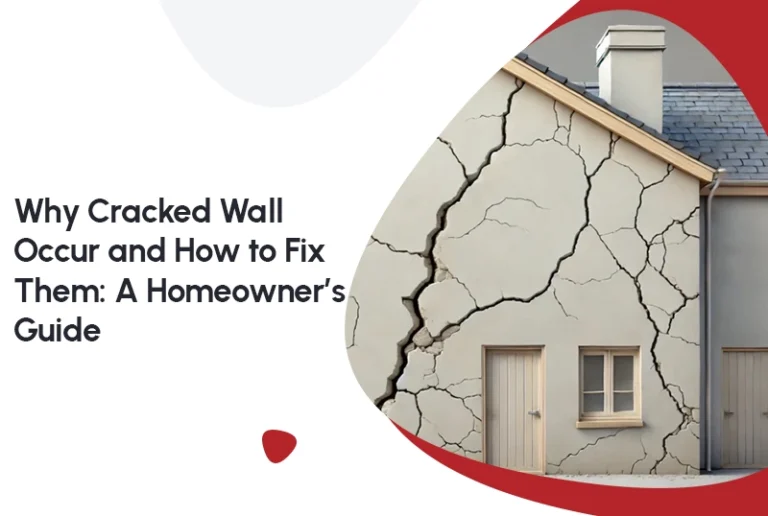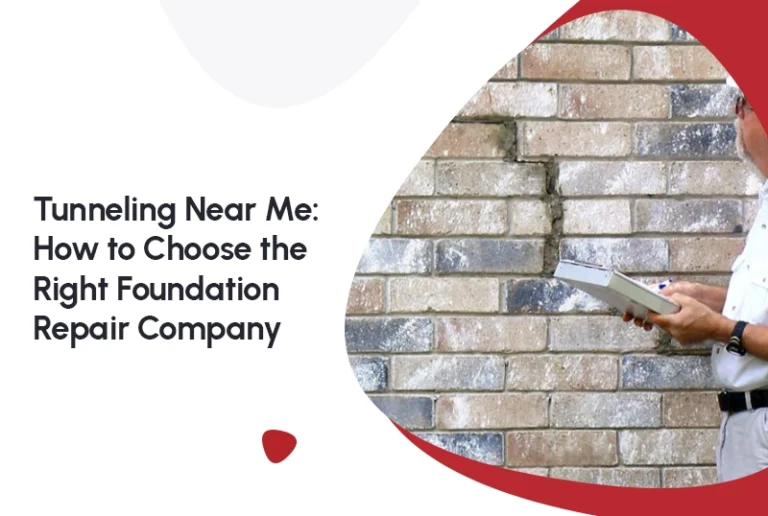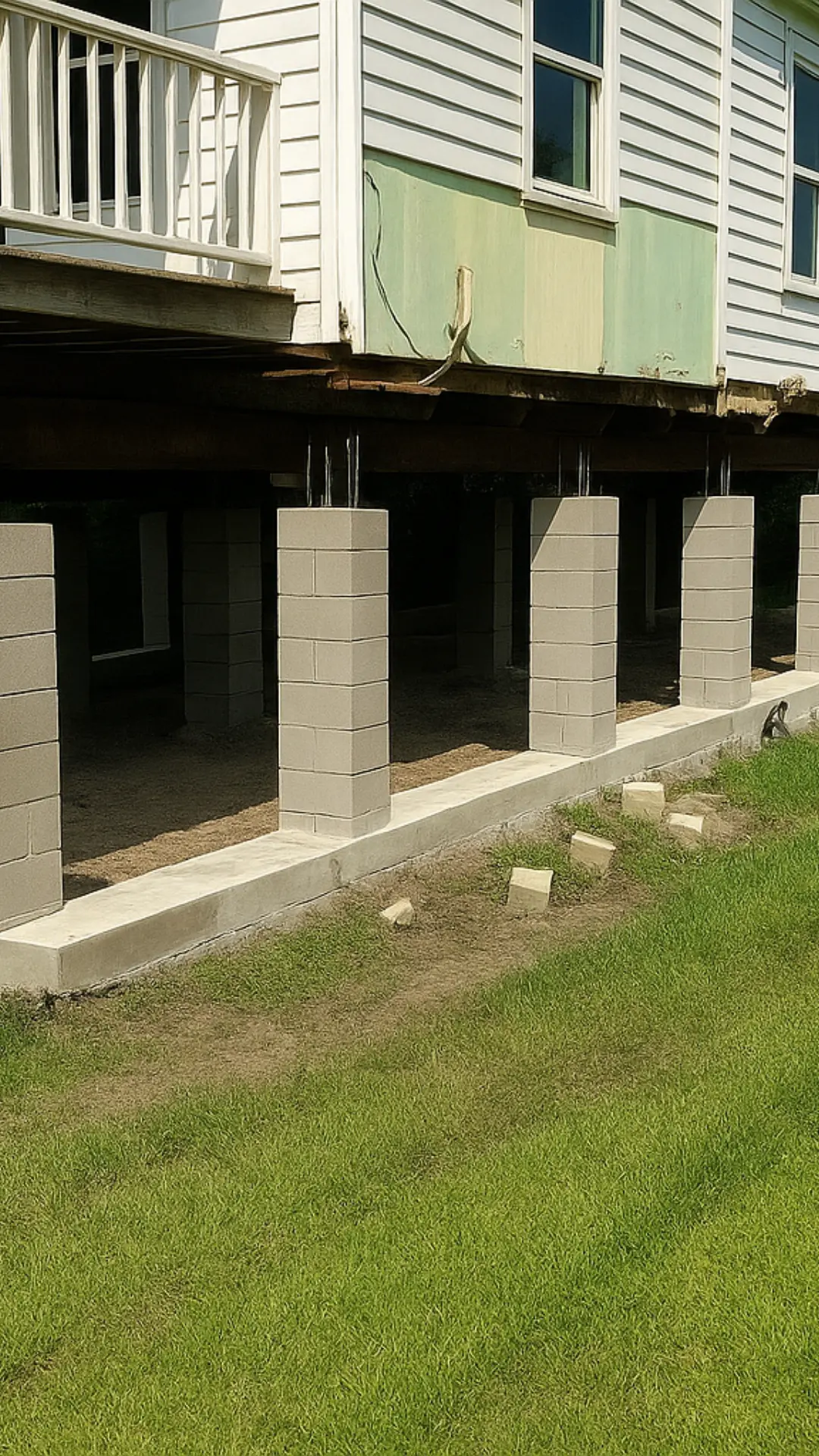Your home’s foundation is the most crucial structural component that ensures stability. If your foundation cracks, it can lead to severe issues like uneven floors, doors that won’t close properly, and even water infiltration into the living space. Foundation cracks, no matter how small they may appear, are a warning sign that should not be ignored.
In this guide, we’ll cover the common causes of foundation cracks, how to identify them, and the best foundation crack repair methods to restore the stability of your home. If you notice cracks or other signs of damage, it’s crucial to take action before the situation worsens.
What Causes Foundation Cracks?
Understanding the causes of foundation cracks helps determine the most effective foundation repair methods. Let’s dive into the primary causes of these cracks:
1. Soil Movement
Soil movement is one of the most common reasons for foundation cracks. Expansive soils, such as clay, expand when they absorb moisture and contract when they dry out. This fluctuation in soil moisture puts pressure on the foundation, leading to cracks. Areas like Houston, where soil moisture fluctuates with the seasons, are particularly susceptible to this issue.
For example, when Emily moved into her new home in Houston, she noticed vertical cracks in the living room walls. After a professional evaluation, it was determined that the expansive clay soil beneath her home had shifted, causing the cracks. Fortunately, foundation crack repair was performed quickly, restoring the stability of the foundation.
2. Water Damage
Water infiltration is another major contributor to foundation cracks When water seeps into the soil under your foundation, it can cause the soil to expand or erode, leading to cracks and uneven settling.
3. Poor Construction Practices
Foundations that were poorly designed or built with subpar materials are more prone to cracks over time. Inadequately reinforced or improperly constructed foundations may not withstand the pressure of soil movement or water damage.
4. Tree Roots
Tree roots can create significant pressure on the foundation as they grow. If large trees are planted too close to the home, their roots can infiltrate the foundation, pushing against the walls and causing cracks.
Kevin, for instance, noticed horizontal cracks in his basement walls. After inspection, it was found that the roots of a large oak tree in his backyard were growing under the foundation. Removing the tree and repairing the foundation helped prevent further damage.
5. Settling Over Time
Over time, all foundations naturally settle. However, uneven or excessive settling can cause cracks. This is especially true for older homes where the foundation has shifted more than expected.
In Austin, a homeowner noticed several cracks in his 50-year-old home. While these cracks were minor, they were caused by natural settling. Foundation crack repair addressed the problem early, ensuring the house remained structurally stable.
How to Identify Foundation Cracks
Recognizing the type of crack is crucial to understanding the severity of the problem. Here are the most common types of foundation cracks:
1. Vertical Cracks
Vertical cracks are usually the least concerning. They’re often caused by settling or shrinkage. If the crack is narrow and not expanding, it may not need immediate attention. However, it’s important to monitor these cracks over time.
2. Horizontal Cracks
Horizontal cracks are more concerning because they often indicate external pressure, such as from water accumulation or expansive soil. These cracks should be repaired immediately to prevent further foundation movement.
3. Diagonal Cracks
Diagonal cracks often appear at the corners of walls due to uneven settling. While not always dangerous, they should be addressed before they widen or cause other issues.
4. Stair-Step Cracks
Stair-step cracks are typically found in brick or stone foundations. These cracks often indicate that the foundation is shifting and should be monitored closely.
Why Foundation Crack Repair is Important
Addressing foundation cracks quickly is crucial for maintaining your home’s stability. Here’s why foundation crack repair is essential:
1. Structural Integrity
A compromised foundation weakens the entire structure of your home, leading to issues like uneven floors and misaligned doors. Timely repairs prevent further destabilization.
2. Preventing Water Damage
Foundation cracks can allow water to seep into your home, leading to mold, mildew, and long-term damage. Repairing cracks early keeps your home dry and safe.
3. Protecting Property Value
Homes with foundation issues are less attractive to buyers and may lose value. Foundation crack repair helps preserve your home’s value and appeal.
Methods of Foundation Crack Repair
Several methods can be used for foundation crack repair, depending on the type and severity of the cracks:
1. Epoxy Injection
Epoxy injection is used for small, non-moving cracks. It involves injecting epoxy resin into the crack, bonding the sides together to restore structural integrity.
2. Polyurethane Foam Injection
Polyurethane foam is injected into cracks that allow water to seep into the foundation. The foam expands, creating a seal that prevents water infiltration.
3. Carbon Fiber Straps
For bowing or leaning foundation walls, carbon fiber straps provide stabilization. This method strengthens the foundation and prevents further movement.
4. Underpinning
For severe cases of foundation damage, underpinning involves installing pier and beambeneath the foundation to stabilize it and prevent further settling.
How Much Does Foundation Crack Repair Cost?
The cost of foundation crack repair varies depending on the severity of the damage. On average, you can expect to pay between $500 and $10,000 for repairs.
- Epoxy Injection: $300 to $800
- Polyurethane Foam Injection: $400 to $1,500
- Carbon Fiber Reinforcement: $1,000 to $5,000
- Underpinning: $2,000 to $12,000
It’s important to get multiple estimates and consult with a professional to ensure the most cost-effective solution.
Preventing Future Foundation Cracks
Preventing foundation cracks is just as important as repairing them. Here’s how you can protect your foundation:
- Maintain Proper Drainage: Ensure water flows away from your foundation by keeping gutters and downspouts clean.
- Monitor Soil Moisture: Keep the soil evenly moist around your foundation, especially if you have expansive soil.
- Regular Inspections: Have a professional inspect your foundation at least once a year.
- Control Tree Root Growth: Avoid planting large trees close to your home, as their roots can intrude into the foundation.
FAQs About Foundation Crack Repair
1. How do I know if I need foundation crack repair?
Signs that you may need foundation crack repair include visible cracks in the foundation walls, uneven or sloping floors, doors and windows that stick or won’t close properly, and gaps around window frames or exterior doors. These issues often indicate underlying movement or settling of the foundation and should be assessed by a professional to determine the cause and severity.
2. Can foundation cracks cause water damage?
Yes, foundation cracks can absolutely lead to water damage. Even small cracks allow moisture to seep into the basement or crawl space, potentially leading to mold growth, mildew, musty odors, and even structural deterioration over time. Water intrusion can also damage flooring, drywall, and stored belongings. Addressing cracks early can prevent these costly problems.
3. How much do foundation crack repairs cost?
The cost of repairing foundation cracks varies widely depending on the extent of the damage, the location of the crack, and the method used for repair. Minor cracks may cost as little as $500 to $1,000 to fix using simple injection techniques, while more severe structural issues may require underpinning or wall stabilization, which can cost anywhere from $5,000 to $10,000 or more. A professional inspection is necessary to provide an accurate estimate.
4. How long do foundation crack repairs last?
When done correctly using the appropriate method and materials, foundation crack repairs can last for many years—even decades. Professional repairs using epoxy or polyurethane injection, carbon fiber reinforcement, or underpinning techniques are designed to provide long-term stability. However, the longevity also depends on ongoing maintenance and environmental factors like soil conditions and water management.
5. Are foundation repairs covered by homeowners insurance?
Homeowners insurance may or may not cover foundation repairs, depending on the cause of the damage and the specifics of your policy. Typically, damage due to natural settling or poor construction is not covered, while damage resulting from covered perils such as plumbing leaks or earthquakes (with appropriate riders) might be. Always consult your insurance provider to understand what is and isn’t covered under your policy.
6. Can I fix foundation cracks myself?
You can repair small, non-structural cracks yourself using DIY foundation crack repair kits, which usually involve injecting a sealant such as polyurethane into the crack to prevent moisture intrusion. However, larger cracks, horizontal cracks, or any cracks showing signs of structural movement should not be attempted without professional help. Improper repairs can mask underlying issues and lead to more serious problems later on.
7. What’s the difference between epoxy and polyurethane injections?
Epoxy and polyurethane are both used for injecting into foundation cracks, but they serve different purposes. Epoxy is a rigid material that bonds the two sides of a crack together and is primarily used for structural repairs. It restores the strength of the concrete but doesn’t expand or flex. Polyurethane, on the other hand, is flexible and expands when injected. It’s ideal for sealing cracks and preventing water intrusion, but it doesn’t offer significant structural reinforcement.
8. How can I prevent foundation cracks?
Preventing foundation cracks involves maintaining stable soil conditions around your home. Ensure proper drainage by keeping gutters and downspouts clean and directing water away from your foundation. Avoid planting large trees or shrubs too close to your home, as roots can disrupt the soil and foundation. Also, maintaining consistent moisture levels around the foundation can help prevent the soil from expanding and contracting excessively, which leads to cracks.
9. What type of cracks are most concerning?
Not all cracks are equal in terms of risk. Hairline vertical cracks are common and often harmless, especially in new homes. However, horizontal cracks, wide vertical cracks, or cracks that are widening over time are typically signs of more serious structural issues. These can indicate pressure from the soil outside, foundation movement, or settling, and should be evaluated by a structural engineer or foundation specialist right away.
10. Should I repair foundation cracks right away?
Yes, it’s best to address foundation cracks as soon as possible. Small issues can turn into major problems if left untreated. Early repairs are typically less expensive and can prevent further damage to your home’s structure, help you avoid water intrusion, and preserve your home’s value. Ignoring foundation issues can lead to more extensive repairs down the line, which are often more costly and disruptive.







